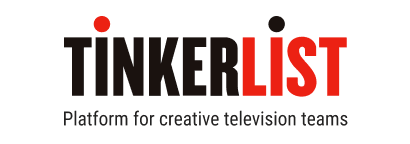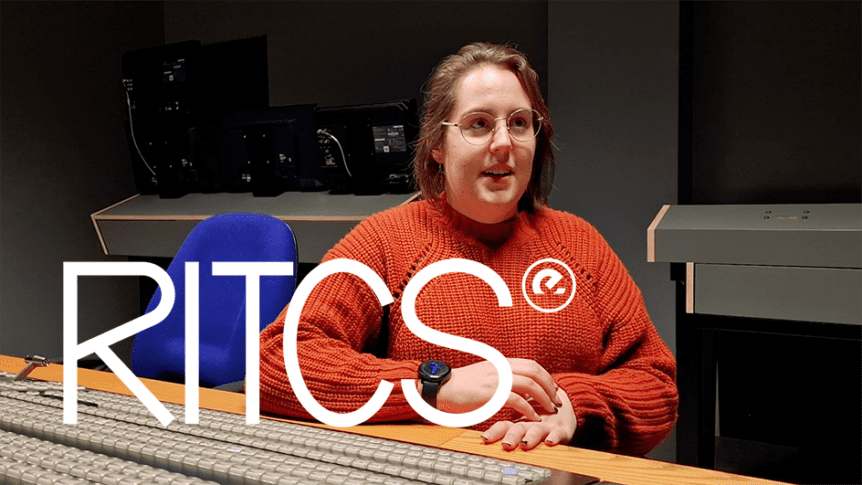RITCS School of Arts welcomed us on campus to have chat with one of their students about their studies and getting taught TinkerList at University.
I think it would have been a mess. The production that I did with TinkerList would have been a mess if we didn’t have the program.
Marie-Lou Obdeijn, Student at RITCS School Of Arts
Who are you and what do you study?
My name is Marie-Lou Obdeijn. I’m a last year Bachelor student in the study Audiovisual Arts for Media and I focus on film and TV production. My main function within that field is producer. We’re here actually in the video recording room where the director, director’s assistant, shader,… Everyone would be here.
What courses are being taught?
The courses in this the curriculum, I would say, in your first and second year you kind of have the same courses that follow along. So for me as a production student, I of course get production management. You also get audiovisual arts and arts history. We get technology courses but as production students, we get like the very basics. The people that study video, audio and technology get a lot more of those. And then you also have media society course focusing on current problems and thematics. Besides that, we have both multi- and single camera practical courses.
Any software classes?
We actually get multiple software classes. Um, so of course, we do use the Adobe Suite a lot here. We get introductory courses to Photoshop, Premiere Pro, After Effects, Illustrator,… I think those are the ones that we use the most. I think we also get like some basic introductory classes into scriptwriting software like Final Draft and Celltx I think we also saw… And then TinkerList of course.
Why did you start using TinkerList?
When we got taught the program, we were actually working- It was in the midst of Corona. So I think they allowed practical courses again, but you could be only with ten people in a room, which is impossible if you make a multi-camera TV show. So the teacher decided to split us up on four different locations. Every single location had a different topic that you had to focus on, different technologies that we could use and every single group had their own director, director’s assistant, camera people,… And then of course you had one ‘head’: the one that was actually shooting in the studio here, that was kind of coordinating everything.
And the use of TinkerList meant that we could work on this one program even though one group of people was working here, well not in this room but here at RITCS, and another group was working at the other side of Brussels in one of the main buildings of Erasmus Hogeschool. So we could still make this program while not having any in-person contact while not even being together all the time. You just saw like: “Okay, this group is talking about this topic, maybe we could like put that in our part too?”
For me also, the ‘live function’ of TinkerList was amazing that we were taught then to really keep track of the timings of like: “Okay well in 10 seconds we go to the next block”, and really counting down like that. And to be able to follow along with: “Okay so we’re currently with that group and that part and we have so many seconds until I need to be ready with my group to go join the live.” It was really a blessing to have that program when COVID came around.
You can watch as many workshops as you want but I think the real handiness of TinkerList will only reveal itself once you’re actually writing a program in it or collaborating with other people.
Marie-Lou Obdeijn, Student at RITCS School Of Arts
How is TinkerList being taught?
We have this in like the first and second year, in four big practical blocks. So that’s three to four weeks where you really only work on the TV show you’re producing at that moment. So we got very like basic introductory to it and for the rest, we were just, you know, given the program, just like: “Here you get to use this. Do with it what you can and kind of figure out how to work with it.”
I think ultimately, this is a program you learn. So you can watch as many workshops as you want but I think the real handiness of it will only reveal itself once you’re actually writing a program in it or collaborating with other people. It’s very user friendly. It’s very intuitive. I had no problem at all getting like getting started with it.
What’s the most challenging thing about your study?
The most challenging thing about this study is really the working in team. You can’t do anything on your own. You can’t do anything on your own in the industry so they really teach you that here at school too. We have lots of group work. And I think the hardest thing is finding your confidence and finding your place within the group you’re working in and really having the confidence to be like: “OK, well, this is my job, I know what my job is and like I’m gonna be doing my job.”
It’s amazing working with everyone, but you also realise that everyone has their own characters, their own sense and what they want to do. And we are- I think like in my first year, we started with about 40 students that all have to work together and… that’s a bit hard when you have to figure everything out. But it’s amazing to see how, when the school year progresses, you really see how people start to get to work together. Like you know who’s good at what and who you can depend on. And who you work with a bit better than with other people.
We get to change things when needed. It’s very flexible and you’re not left with 10000 versions of the same document because the document is still there online. I think that’s what’s technology really gave us as a group.
Marie-Lou Obdeijn, Student at RITCS School Of Arts
Does technology facilitate those challenges?
Technology definitely facilitates that challenge. We get to be in contact a lot more. I would say even- Like of course you’re working together at school, but you also get to then like go home, think about it,… and technology allows us to have meetings at home to just chat about it, to make documents. But it also allows us to actually test things out, to try different camera angles and already put them together or try different things with lighting.
And so because of technology, we are not rushed to be like: “Okay we need to do like one perfect thing.” We get to try and play around. And I think that’s one of the things I also loved about TinkerList while using it, is that of course, we had our meetings together at the school and we discussed things, but we’d all influence each other. But then everyone could go home, do their own thing, still log in, work in the same place, and then the next morning I log in and see: “Well oh, we’ve actually made this type of progress last night and that’s ready and that isn’t…”
We get to change things when needed. It’s very flexible and you’re not left with 10000 versions of the same document because the document is still there online. I think that’s what’s technology really gave us as a group.
How did you experience TinkerList?
The functionality of it reminded me a lot of like a combination of Google Docs, like the Google Suite, and even the drag and drop functionality of Wix, the website builder that allows you to really build the script and put in the different items that you need: not only text, but also be able to add question cards, be able to add pictures into it tailored to what we need. And the chatting function in TinkerList was also amazing to use. So you could just have like this one window open, sometimes having to switch to whatever other chatting medium you’re using. If you’re working remotely with your team you have this like pop-up chat in the program itself.
I think the only thing that for me that felt like I had a little bit to get used to was the vertical horizontal program view that you could like scroll and see- like have different windows open at the same time. But as I got to use it, it was also very handy to just be able to like: “Okay swipe that’s what I need now. Swipe that’s the next thing.” And be able to really work on multiple things at the same time. For example multiple episodes at the same time that you just have open.
What would you use if it weren’t TinkerList?
If we didn’t have TinkerList, I think the closest program would be Google Docs, again because of the
working together. Well, I would say at school we also work a lot with Microsoft Teams. And so I would say that the working together function on Word and Excel would be the one that we would use the most. But I think a lot of it would also just be with printing out papers and just having multiple versions of the same thing and a thousand emails with different changes that need to happen.
I don’t think there’s one solution for how we would have- I think it would have been a mess. The production that I did with TinkerList would have been a mess if we didn’t have the program.

